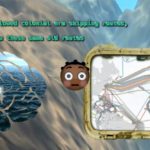Tabita Rezaire
Deep Down Tidal Premium Connect
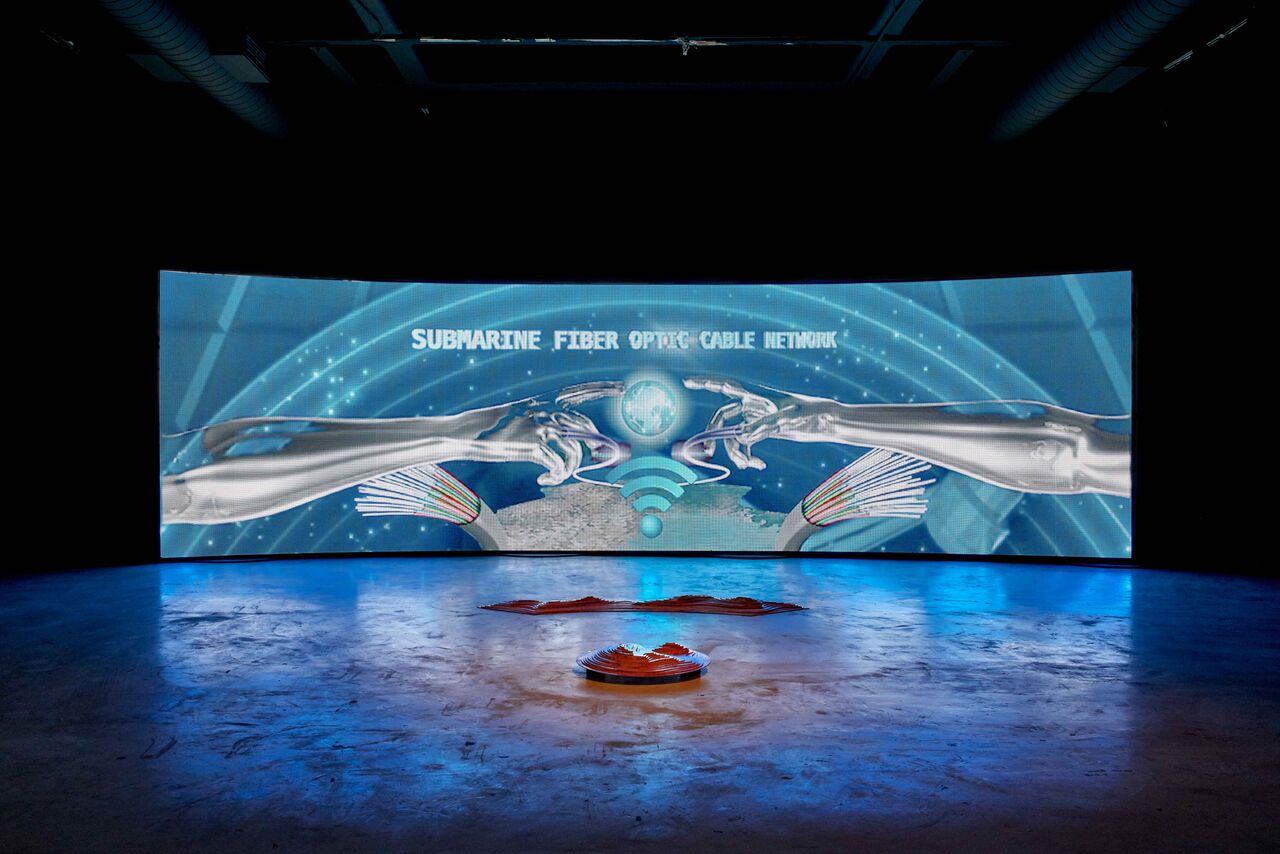
Tabita Rezaire, Deep Down Tidal, 2017. Installation View: Goodman Gallery, Johannesburg. Image courtesy the artist and Goodman Gallery, Johannesburg.
Technology is not just physical apparatus, it’s the song of the trees, of the wind, the mountains and the ocean. It is the collective wisdom of ancestors that has been passed down through generations.
The technology of healing as a technology of information is the ability to receive communications from matter, emotions, ancestors, ancestors in matter, the body, the atoms, the cells. We call this communications technology, which is to say an ancestral technology of knowledge, an ancestral technology of information, knowledge technology, genetic technology, knowledge communication technology. So when we are separated from our ancestral technology of knowledge, we are colonized, we are disconnected. We lose this ancestral technology of communication.
The first transatlantic cable was laid in the 1850s to send telegraphs between Newfoundland and Ireland. Now hundreds of cables – some as thin as a strand of hair – stretch 750,000 miles along the ocean floor, connecting the continents with fiber-optic technology. Lasers propel data down the threads at almost the speed of light; once ashore, this data makes its way onto your computer, lapping the world again before you finish this sentence. Despite recent advances in wireless and satellite technologies, fiber-optic cables remain the fastest and cheapest way to send information across the ocean. Looking at maps delineating the pathways of these snaking cables, something else becomes apparent: the path of the internet mirrors the path of colonial trade routes, where tobacco and rice were exchanged for enslaved Black human bodies.
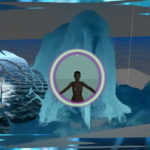
Tabita Rezaire, Deep Down Tidal, 2017. Image courtesy the artist and Goodman Gallery, Johannesburg.
In Deep Down Tidal (2017), the French artist Tabita Rezaire unravels the technologies and geopolitics of electronic colonialism, merging the cosmological and spiritual qualities of the ocean with its historical and contemporary use as a vessel of power, world-making, and exclusion. Taking note of the many ways the internet is “exclusionary, classist, patriarchial, racist, homophobic, and transphobic” – and how it uploads the hegemonic power structures and Eurocentric knowledge systems central to settler colonial world-views, rebranded today as global capitalism – Rezaire excavates the spatial and architectural dimensions of its hardware. Far from existing immaterially in the Cloud, as Big Tech puts it, the internet materially exists as a tangle of cables on the seafloor. Through a morphing montage of net.art aesthetics – pixelated 3D worlds, retrofuturist MS WordArt, plasma avatars and greenscreen gongs aplenty – Deep Down Tidal deletes the myth of globalization as a necessarily progressive universal process.
Decolonial technologies are continuously transforming our politics, like the internet is continuously transforming our culture. But in South Africa we have a long history of colonisation where we lost our intellectual knowledge. One of the things I do is talk about teknologies – what they are and where they come from. I start by asking a question: ‘What is a technology?’ And then ask, ‘What is an indigenous technology?’ – because we no longer recognize that some of the things we call technologies are actually technologies we had before colonisation.

Tabita Rezaire, Deep Down Tidal, 2017. Image courtesy the artist and Goodman Gallery, Johannesburg.
Throughout the trippy widescreen narrative, Rezaire superimposes the pathways of colonial shipping routes with these deep-sea communication systems to reveal a near-perfect overlap. A camera pans through cavernous underwater virtual space, while an overlaying of digital flotsam – iOS emojis, found footage of ocean ecologies, wifi symbols, maps of the world, and 3D models of submarines – collage together as the woozy visual identity of this new imperialism. Exploring how the bulk of these cables connect the Americas, Europe, and China – but leave the majority of the African continent with low-speed dial-up – Rezaire expands on how the internet sustains the dependency of former colonized countries on the West.
Towards the end, Deep Down Tidal pivots in focus, drawing a parallel between the flow of digital information through deepwater networks and the ways water moves through our bodies. Oil rigs, fish spines, plastic bags float on top of CGI rivers of blood, while potent and poetic MS WordArt slogans roatate ad infinitum: Power fluids, fractal resilience, water remembers. “As our data traverse these histories,” suggests Rezaire, “these waters in which some of our ancestors have rebelled, given birth, drowned or carried with them their sacred sciences and chants to other lands, we may also be given an opportunity to cleanse these routes. The research of Masaru Emoto suggests that water has the ability to memorize and copy information, disseminating it through its streams. Water is a technology of information and communication. The most ancient hard drive.”

Tabita Rezaire, Deep Down Tidal, 2017. Image courtesy the artist and Goodman Gallery, Johannesburg.
“We will download your secrets,” the video talks back. A dancer with a python snaking around his back rapidly multiplies, suspended on a changing montage of planets. In closing, Deep Down Tidal’s narrator speaks of aquatic revenge, the flooding of a virtual city, while also regaling water’s healing properties, its flowing network an aqueous stitching together of people, soil, ground, plants, planet. “Out of you flow rivers of living water.” Can water serve as a kind of decolonial technology?
When I ask audiences that question, they usually say, ‘Technology is a motorcycle.’ And I say, ‘Do you think that a motorcycle was invented?’ Then I start telling them about the technology of building a motorcycle, which is the technology of metalworking. Which came from the technology of processing iron, which came from the technology of smelting.
So actually, to make a motorcycle you have a whole chain of technologies. You can trace those back through hundreds of years – this is what I call ‘hardware technology’. Hardware technology has an architecture, which is the architecture of buildings, of instruments and machinery, of computer systems, and of all the other things we use to communicate and to exchange information. So ‘hardware’ is the ‘hard’ part of technology.
But technology also has the ‘software’. This is the ‘software’ part of the technology. And the software part is much more nebulous. Just as our software for our computer comes from the hardware part, our software part is a result of how we communicate. So, our software has an architecture which is a communication syntax, a communication grammar. The software part enables us to communicate through our hardware. So, by talking about the syntax and the grammar, you change the architecture. This means that we can change a technology, and improve it, just by changing the communication grammar.
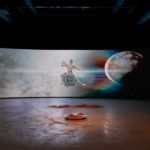
Tabita Rezaire, Deep Down Tidal, 2017. Image courtesy the artist and Goodman Gallery, Johannesburg.
Based near Cayenne, in French Guyana, Rezaire is currently developing AMAKABA – a healing and educational center in the Amazonian Forest. Still in its seedling phase, the project reflects Rezaire’s broader intention of bridging the mind-body-spirit-technology divide through ancient knowledge systems and ecological reciprocity. Working from a time-space where technology and spirituality have merged, Rezaire’s practice channels the mystical capacities of network sciences – both organic and electronic, screen and spirit – as healing technologies.
In Premium Connect (2017), Rezaire unearths a mystical techno-consciousness through a new study of information and communication technologies (ICT) that infuses African cosmologies, underground plant networks, quantum physics, and ancestral divination. In dialogue with Yoruba School Nigerian philosopher Sophie Oluwole, the physicist Sylvester James Gates, and cybernetics and ethnomathematics scholar Ron Eglash, the work uncovers the origins of deterministic chaos theory, fractal theory, complexity theory, binary mathematics, and geomancy as rooted in traditional African knowledge systems. Building on a growing body of research, Premium Connect makes the case through an assemblage of net.art graphics and that the temporal traditions of African societies – once dismissed by colonizers as evidence of primitive superstition – appear in the most advanced fields of computer science and cosmogenic theory.

Tabita Rezaire, Premium Connect, 2017. Courtesy the artist and Goodman Gallery, Johannesburg.
“You seem to have forgotten that it was the love for inventing new things that caused the destruction of the First people,” admonishes a disembodied narrator reading from a disappearing text styled like the Star Wars opening crawl. An extruded digital landscape flips and dilates itself to reveal the face of a distorted avatar. Cut to greenscreen of a woman in an anakara fabric dress texting atop a glitchart backdrop; a plasma-encrusted floating chat bubble harkens back to iOS6. The texters discuss the powers and pitfalls of knowing the future, interspersed with memes mined from Apple’s GIF Search Engine. Suddenly, a 3D WordArt graphic remarking “Remembering the future is hella LIT” tumbles across a glitching backdrop, quickly subsumed by a rendered computer system that states matter-of-factly: “divination is the act of accessing unknown information”.
In Yoruba cosmology, a poem is often used to deliver the knowledge within a story. For example the Odu Ifa – oracle of Ifa – are often recited in poetic form. As is the case with most indigenous knowledge systems, it is passed down through oral means. Historically, the cosmological story of creation has had many layers of understanding for different stages of initiation. So while a child may access a cosmological story of creation with mythological motifs and colourful characters, initiates will have access to the layers of understanding that reflect matter, energy, and consciousness. No matter what story of creation is being told, at its core, it is an allegory for how creation really works.
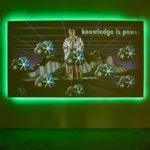
Tabita Rezaire, Premium Connect, 2017. Installaton view. Courtesy the artist and Goodman Gallery, Johannesburg.
“Knowledge migration started in the 12th century when the Almoravid Muslims invaded the Ghana Empire,” shares the voice of Oluwole over a fluorescent pink graphics card, followed by a flickering binary code GIF of Matrix-style lore. (She later appears within the embossed image of a cowrie shell). The idea of divination was translated from Arabic to Latin, but it came from African cosmologies. Binary codes, the foundation of computing science – the computer’s mother tongue – came from the Ifa divinatory binary system, but because it was religious in origin, it was not taken seriously.
As the video progresses, it pits daily anxieties over privacy on social media against supersymmetric algebras representing string theory equations. “Do I live in the Matrix?” questions the glowing floating head of physicist Sylvester James Gates as game show music plays. Periodic cameos of Morpheus from the Matrix present soundbites of epistemic wisdom and pop-up GIFs of Facebook likes buoys up the hardcore historical legwork by Oluwole and Rezaire that link African cosmologies and modern computing code. Towards the end of the video, the serial texter returns, offering a final piece of wisdom: “A piece of data is an abstract information. In order to read this data, we must encode it into a format we understand. We could potentially see the world differently through another format.”

Tabita Rezaire, Premium Connect, 2017. Courtesy the artist and Goodman Gallery, Johannesburg.
Suturing together the organic, technological, and spiritual worlds, Premium Connect asks us to listen to the natural telecommunications systems of this more-than-human world – from mycelium networks to a speculative ‘wood wide web’ of a forest internet – to understand the true breadth of knowledge that nature offers us. This link was understood and celebrated by the Yoruba people many hundreds of years ago, after all. Rezaire’s work requests the double act of leaning into the organic edge of technology and uploading ourselves to the technological edge of spirituality. As two desktop folders engage in a perpetual document transfer, Gates sounds again, reminding us that our individual brains are, in fact computers. To attempt to answer the universe’s most complex questions in the limited world-view of our own operating system is no doubt futile. Instead, we ought to log onto the collective cosmological consciousness of the wisdom of our ancestors – which is to say, the decolonial internet – “a divine record of consciousness”. Is this kind of consciousness editable, like a shared Google Doc? Are the changes tracked?
Yes! That would mean that the creation of the universe is a text that can only be read and decoded by the reader and decoder themselves. And where are the readers and decoders? They, too, are text. So therefore human experience is a text that can only be read and decoded by the reader and decoder.

Tabita Rezaire, Premium Connect, 2017. Courtesy the artist and Goodman Gallery, Johannesburg.
What if the origins of the universe weren’t stowed away in a shared .txt file, but something more sensory and fleeting? For instance, a sound?
“From the cosmic primal sound, all material form – as in matter – was birthed and still keeps birthing,” suggests Rezaire. “Everything has a vibratory frequency, even if inaudible, and this is the result of the primal sound, which set creation into motion. We are ‘only’ sonic residues from our cosmic sonic beginnings. The human pursuit is then to find that sound and resound in that sound, so as to vibrate in unison with the vibratory frequency of infinity. This is the ultimate healing…”
…meaning, there is a rhythm, there’s a spiritual vibration, there are songs, there is a celestial beat. And that is the physicality that is the origin of existence, and is the cosmological creation, it’s inside the human as well. So it’s not really a story, it’s a poem. Because it is a poem; it’s a vibration, it’s something that you feel as opposed to a story where you see the pictures..
A cosmic beginning without images: what could take their place? As much as it relies on the visual language of the internet, Rezaire’s work ultimately uses net.art aesthetics as a kind of trojan horse for exposing and dismantling the many problematic architectures of the internet and the very idea that the global connectivity it offers is anything new or even human-made. Deep Down Tidal and Premium Connect speculate on an internet removed from global finance systems, a kind of proto-internet that exists within ancient organic telecommunication systems, trained on non-materialist, non-western world-views and creation myths, the cultural and spiritual practices of indigenous cultures, plant knowledge, a techno-consciousness could nurture, in Rezaire’s own words, a “mind-body-spirit-technology” symbiosis.
“Beyond the frenetic drive for growth motivated by profit and the insatiable thirst of capitalism are other worlds. Worlds we dream, worlds we draw, worlds we sing. Worlds where visions are real, where flowers speak, and water heals. Worlds we download and upload into manifested reality.”
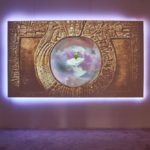
Tabita Rezaire, Premium Connect, 2017. Installaton view. Courtesy the artist and Goodman Gallery, Johannesburg.
Technology is the organic sound of life. It is the presence of that which is invisible. What is invisible is noticed out of the corner of the eye.
It’s how the ants know in which direction to go to build their nest,
how the bees communicate with each other through their hymns,
with the fish in the sea, the cycles of the seasons, the cycles of the moon.
It’s the unseen movement that animates our bodies
when we’re in alignment with the universe.
Technology is how we move when there is a certain intention behind it.
When we’re clear about where we want to go, and we envision it well.
It is aligning with the organizing principles of the universe.
Tabita Rezaire, Premium Connect, 2017.





